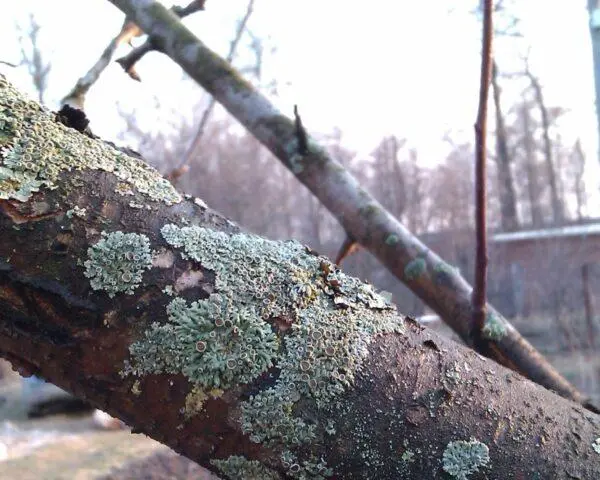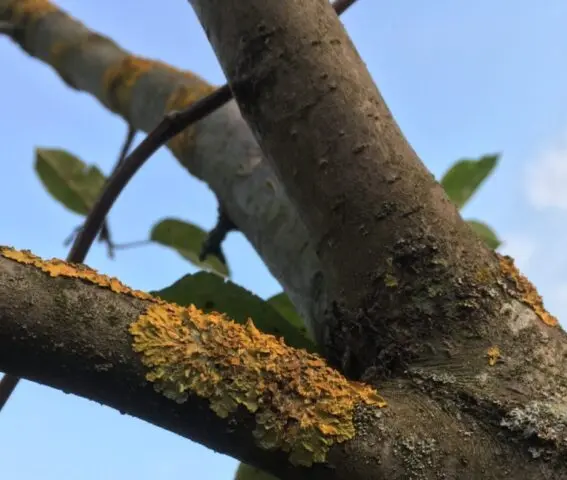Contents
Lichen on an apple tree appears on the surface layer of the bark, especially in cracks, crevices and other weakened parts. By itself, it is not a parasite, but contributes to the development of other pathologies, including dangerous fungi and insects. To combat it, the surface of the tree is cleaned, then treated with folk remedies or special preparations.
moss species
Mosses belong to one of the largest groups (divisions), numbering approximately 10 thousand plant species. Lichens are another division, represented by over 26. These plants often cover the damp bark of fruit trees, including apple trees. Outwardly, they look about the same – the surface layer of different shades. Therefore, in garden practice, mosses and lichens have become interchangeable concepts.
Moss is a classic plant, while lichen is a symbiosis (close union) of algae and fungi. First, unicellular algae settle on the wet surface of the bark of an apple tree. They create the primary substrate into which fungal spores enter. Due to moisture, heat and nutrients, they quickly develop and cover individual parts of the trunk and branches.
Depending on the nature of the cover, lichens can be of the following forms:
- scale;
- scaly;
- bushy;
- lamellar.
As for mosses, among them are the following types:
- sphagnum;
- hepatic;
- oak;
- leafy;
- andreevs and others.

Lichen on the trunk of an apple tree
Why is the trunk of an apple tree covered with moss
Unlike lichens, mosses do not grow roots on apple trees and other surfaces. It does not bloom, but at the same time it is more hardy. Therefore, it is impossible to completely insure against the defeat of a tree. Most often, the following reasons lead to this phenomenon:
- Too dense crown branches, lack of timely pruning
- Poor condition of the root system, including due to excessive watering, proximity to groundwater.
- Sunburn in hot summer.
- Unfavorable weather conditions that lead to cracking of the bark and a general weakening of the apple tree.
- Mistakes in care (for example, unbalanced watering, excess nitrogen fertilizers), which can also lead to peeling of the surface layer of the bark.
- Diseases and pests that weaken the tree and spoil the bark (for example, carpenter beetles).
Do I need to remove moss from an apple tree
The lichen is not a parasite. Unlike insects, fungi or bacteria, it does not feed on the juices of the apple tree itself. Cells live on dust and moisture from the air. If the organism settled on the branches, this indicates that the environmental conditions of the area (especially the air) are quite favorable.
But over time, lichens gradually grow due to reproduction. The layer blocks the access of oxygen to the tissues of the apple tree, which makes breathing difficult. In conditions of limited oxygen supply, bacteria, insects and other pests begin to actively develop. Lichens create a favorable substrate for the appearance of other fungi that cause powdery mildew, rust, brown spot and other dangerous diseases of the apple tree.
Therefore, despite the harmlessness of the lichen itself, it is definitely necessary to remove it. Some gardeners believe that during the heat, the crust will dry out and die. This is correct, but only partly. In fact, lichens and mosses are unpretentious, and when wet weather sets in, they recover quite quickly.
Signs of defeat
The main sign of damage to the apple tree by lichen is the appearance on the surface of the trunk or branches of a small layer, the color of which can be quite diverse:
- silver grayish;
- greenish yellow;
- golden;
- blue.

Lichens can have different colors
Over time, secondary signs of damage appear:
- the bark acquires an uncharacteristic yellow or greenish tint;
- apple tree leaves dry up and die;
- black dots and small swellings appear on the fruits.
Initially, they form a barely noticeable grayish layer. Already at this stage, it is important to start the fight – then the problem can be solved in just a few hours.
What to do if the apple tree is covered with lichen
If yellow or other types of lichen appear on the apple tree, you can deal with them in different ways. First of all, it is necessary to clean the surface (mechanical impact). After that, the affected parts must be treated with folk remedies, and, if necessary, with chemical preparations.
Mechanical impact
First you need to try to remove moss and lichen from the apple tree mechanically. Most often, a wooden (but not metal) scraper is used for this. Moreover, it is better to start work in the spring after snowmelt, when there is a lot of moisture in the tissues.
Cleaning is carried out carefully, removing all affected parts. Moreover, a canvas is first covered under the apple tree so that all parts of the lichen can be carried away and burned. The fact is that they can be inhabited by pests, for example, bacteria, insect larvae or fungal spores. You need to work carefully so as not to damage a healthy bark.
It also happens that quite deep cracks remain on the bark, especially in old apple trees or with severe damage. They must be covered (after stripping and treatment with the drug). To do this, use the following compositions:
- clay;
- clay talker with manure in a ratio of 1: 1;
- garden var. You can cook it yourself or buy it in the store.

First, the growths are cleaned off, then treated with garden pitch
Folk remedies
Even if it was possible to completely remove the lichen from the apple tree, the affected parts and neighboring branches must be sprayed with special disinfectants. To do this, you can use proven folk remedies, for example:
- Take 1 kg of lime and dissolve in 10 liters of water. With this solution, several treatments are carried out with an interval of 3-4 days. The prescription helps if the affected areas are small.
- A mixture of 1 kg of salt, two pieces of laundry soap (pre-grind) and 2 kg of wood ash in 10 liters of hot water. Infuse for several hours before cooling and coat the damaged parts of the apple tree.
- A mixture of slaked lime (600 g) with powdered sulfur (400 g). Lime is dissolved in 500 ml of boiling water and boiled over very low heat, stirring constantly. After a few minutes, add sulfur, previously diluted in 1,5 liters of cold water. Then continue to stir and cook for another 15 minutes until the moment when the solution turns red. The concentrate is diluted 50 times, i.e. take 200 ml per 10 liters of water and start spraying the apple tree. This is a very effective tool that allows you to completely destroy the lichen in just 2-3 days.
- Another option is to mix 2 kg of lime with 3 kg of table salt and 20 g of wood glue. All components are dissolved in 10 liters of water and mixed thoroughly. Then they let it brew a little and start processing the branches and trunk of the apple tree from the lichen.
Folk remedies do not always give the desired effect, but they are indispensable for processing during the fruiting period. In addition, they are used in the early stages of damage, so as not to “overload” plants and soil with chemicals.
Preparations
Folk remedies do not always give a good result, therefore, in some cases, it is necessary to treat the apple tree from lichen. Since this plant is based on fungi, it is recommended to use fungicides, for example:
- “Skor” is a systemic drug. Consumption rate – 2 ml per 10 liters.
- Bordeaux liquid is a copper-containing agent. For processing, you will need a concentrated solution of 3%. If the lesion is very severe, the dosage is increased to 5%. It is desirable to spray from early spring before bud break (at least twice).
- “Iron vitriol” is another fairly strong remedy. Apply in the form of a solution with a concentration of 3% to 5%.
- “Fundazol” is a fungicide whose active ingredient is benomyl. Consumption – 10 g per 10 liters.

“Bordeaux liquid” – one of the most effective and inexpensive fungicides
Processing of apple trees from lichens is carried out in the late evening or early morning. The weather should be dry and calm. It is important to take into account the waiting time – the minimum period after which you can start harvesting (usually 10-15 days). This information can be found in the instructions.
This is done for preventive purposes, not only from lichens, but also from fungal diseases.
If apple trees dry from lichens
With severe damage, the bark can dry out. This is one of the consequences of the active spread of lichens, which can lead to the death of branches and even the death of the entire tree. Treatment should begin immediately:
- Peel the bark of apple trees.
- If the wood is black, it is a sign of cancer. Such places need to be cleaned to a healthy part.
- Collect and burn all scraps.
- Treat with a powerful fungicide.
- Coat with clay or garden pitch.
If an old apple tree is affected by lichen, it is better to immediately cut off half of the branches. The affected layers are removed from the remaining half using a wooden scraper. Cleaned places are treated with iron sulphate with a concentration of 3-5%.
preventive measures
The appearance of lichens and mosses on an apple tree can be completely prevented. Experienced gardeners recommend regularly inspecting trees, as it is very easy to deal with the pest in the early stages. In addition, the following preventive measures must be observed:
- When choosing a landing site, exclude lowlands and those areas to the surface of which groundwater is close. The increased humidity of the soil and air creates optimal conditions for the development of lichens.
- Regularly prune, avoiding excessive thickening of the crown. Shearing starts in late autumn, as well as in early spring. All wounds after pruning must be treated with garden pitch or charcoal powder.

- In autumn, be sure to remove fallen leaves, bark, branches and other plant debris. It is better to burn them, not using them on the farm.
- Regularly whitewash the bole to a height of at least 30 cm. At the same time, copper sulfate (3 g) per 150 liters should be added to lime (10 kg). This is a good remedy for the prevention of lichens and other pests of the apple tree.
- Avoid excessive watering, overfeeding with nitrogen fertilizers. This can adversely affect the condition of the bark, leading to cracking and peeling.
- Loosen the soil regularly, lay a layer of mulch, especially for the winter (straw, needles, sawdust).
- If the tree is old, severely affected by lichens or other fungi, it is easier to cut it down so as not to infect neighboring plantings.
Conclusion
Lichen on an apple tree is a rather dangerous phenomenon, which over time can lead to the death of a tree. It does not parasitize, but can provoke the appearance of pests and diseases. Therefore, the branches should be regularly inspected and, if necessary, immediately begin treatment.










